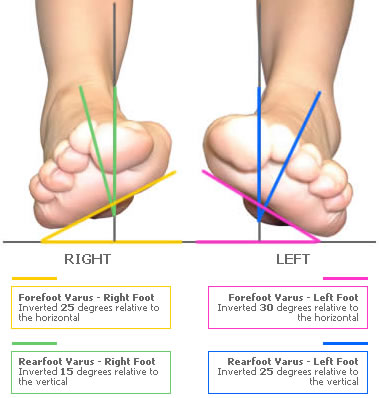Foot Shape Assessment (Sub-Talar Joint Neutral)
Assessing foot shape means identifying the natural varus and valgus deformities (foot shape variations), and to do this the foot needs to be in it’s neutral position, where the sub-talar joint is neither pronated or supinated.
Because the Sub-Talar Joint controls the degree of pronation and supination throughout the Gait Cycle, it is only possible to find the foot’s true foot shape when this joint is neutrally aligned in a non-weightbearing position.
Sub-Talar Joint Neutral
With the patient lying on their front (prone) and with their feet free of the end of the table, the Sub-Talar Joint is placed in neutral. The position of the rear and fore of each foot is then measured (usually by eye), relative to the vertical and horizontal respectively.
A very rough and ready guide for assessing foot shape at home is to stand on one leg or lie down, and shake the free leg and foot around to loosen the muscles. Allow the foot to come to rest naturally, and then have someone look at the position in which the foot naturally falls.
There are some great video’s on you Tube explaining how to find sub-talar joint neutral, such as this example (its feels like you’re right there in a podiatry class!).
It’s worth noting in this video, the terms Pronator and Supinator are used to explain the shape of the foot non-weightbearing, rather than the action it actually causes when the foot comes into weightbearing contact with the ground. On Root2Being, I use the term Pronator foot shape to explain a natural varus deformity as seen non-weightbearing, which causes the foot to overpronate when weightbearing. In this video, this is termed a Supinator foot (because the varus deformity makes it look supinated when non-weightbearing).
Normal foot shape
In a Normal foot shape, when the sub-talar joint is placed in it’s neutral position, the alignment of the foot will be ideal. Where this is the case, both of the following will be true:
a) The vertical bisection through the calcaneus is in line (parallel) with that of the lower leg;
b) The horizontal plane of the forefoot is at 90 degrees (perpendicular) to that of both the calcaneus and lower leg and is parallel to the ground surface.
Pronator and Supinator foot shapes
Any insufficent or excessive torsional untwisting of the calcaneus and/or talus will be evident as a varus (twisted inward) or valgus (twisted outward) deformity within the rearfoot and/or forefoot respectively.
Pronator foot shape example
In this example of a severe bilateral varus deformity (author of Root2Being), the following deductions can be made:
- The left foot is the most severely affected, where torsional untwisting of the calcaneus (rearfoot) and talus (forefoot) stopped approximately 25 and 30 degrees short respectively of their ideal alignment;
- The relative forefoot varus (difference between the forefoot and reafoot varus on the same foot) is greater on the right (approximately 10 degrees) than the left (approximately 5 degrees). This is represented by a more developed bunion on the right compared to the left;
- The actual (degrees of) forefoot varus on the right is less than that on the left.
Calculating the exact degrees of misalignment are not necessary. It is the relative angular relationships between the four quarters of the foundation that are important, and how this impacts the function of the foot throughout the gait cycle.
